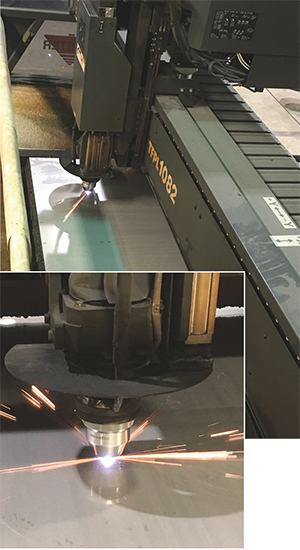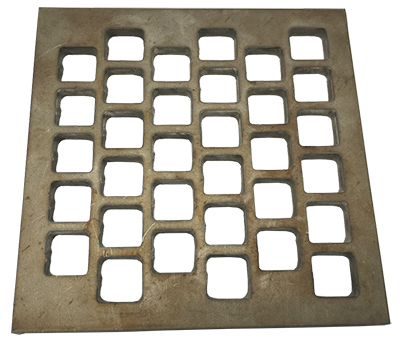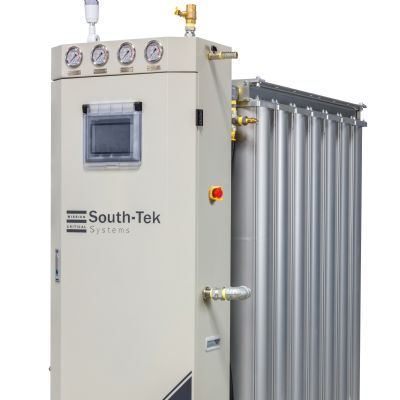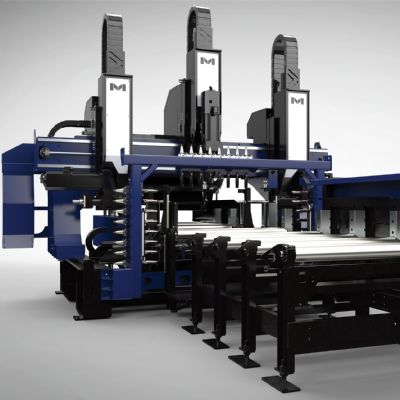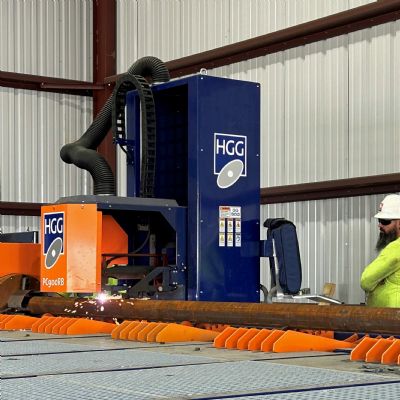SAI’s cutting machine offers a cutting width of 8 ft. The gantry carrying the cutting head rides on track that allows for a maximum plate length of 21 ft., with the option to add track as needed down the road. Cutting speed ranges from 30 to 200 in./min., with a rapid-traverse speed of 1000 in./min. A zoned downdraft table takes care of fume exhaust. And, in addition to the plasma torch, SWI purchased an optional oxy-propane torch attachment, for cutting thick plate beyond the PAC-torch capabilities. Changeover to oxyfuel cutting takes just a minute or so.
Oxidation-Free Stainless Edges
Santiago also highlights the PAC machine’s unique ability to clean-cut stainless steel from 1⁄8 to 11⁄8 in. thick, leaving a cut edge face free from oxidation. This results, say Komatsu officials, from the addition of propane to the process as a shielding gas, mixed into the nitrogen carrier gas. Komatsu calls this the QuickSilver process—during cutting, the propane breaks down to provide free hydrogen that prevents oxidation of the cut edge.
“We accomplish this without having to use expensive pre-mixed plasma gas,” adds Corcoran, referring to the commonly used hydrogen-nitrogen blends available in gas cylinders. Instead, SAI delivers gas to the cutting machine via liquid cylinders of nitrogen, propane and oxygen—again, mixed at the cutting head.
“We’ll cut with nitrogen on Type 316L stainless steel,” says Santiago, “with the propane assist. On carbon steel we’ll cut with oxygen, and mix in nitrogen as material thickness increases. And for marking, we use argon to scribe an array of features—press-brake bend lines, part ID, punch centerpoints, etc.”
That process, as well as the cutting process, is managed by SigmaNest nesting software. It directs all scribing functions throughout the entire sheet nest, and then commands the machine to switch over to cutting mode. That seamless move from scribing to cutting occurs in seconds, again made optimally efficient since there’s minimal gas purging required. The process also benefits from state-of-the-art microprocessor-based control of cutting speed and torch height, power-supply parameters, and plasma- and assist-gas flow rate and pressure, all of which store in the machine’s control database.
Automation is essential to ensuring high overall equipment effectiveness, so that operators need not spend a lot of time fine-tuning the machine. But, are there times when stored process parameters, primarily supplied upon installation of the machine by Komatsu, need to be tweaked? “Definitely,” says Santiago.
“For example,” he continues, “there are times when I have increased torch height for piercing to ensure slag doesn’t blow back into the torch head. And, I had to develop a cutting-parameter program for cutting 1.25-in.-thick stainless steel, since the database only included programs for cutting stainless steel to 11⁄8 in. That was not difficult; I just bumped up the gas-flow and amperage settings from the original program, increased torch height and pierce-dwell time a bit, and made some test cuts until I had the program set perfectly. Then I saved the new program to the control.”
High-Definition Cuts Ease Field Work
Not to be overlooked, adds Corcoran, is the upgrade from standard or traditional plasma cutting to the high-definition process. Simply, high-definition cutting employs a specially designed cutting-head orifice that tightly shapes the plasma arc to optimize energy density. The result is squarer, smoother cuts without compromising cutting speed or consumable life.
“We used to experience issues in the field,” Corcoran says, “where our installation crews would have to ream out plasma-cut bolt holes due to edge taper. Or, we’d have to ask engineering to oversize the holes. Neither practice is very efficient. Now, the high-definition process completely avoids those issues.” MF
View Glossary of Metalforming Terms
See also: Komatsu America Industries, LLC Press Technology Division
Technologies: Cutting







